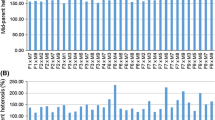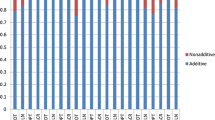Abstract
Aluminium toxicity in acidic soils (Al) and the maize streak virus disease (MSV) cause significant losses in maize productivity. These constraints can occur simultaneously in sub-Saharan Africa but there are no maize hybrids that combine resistance for both stresses. Therefore, the objectives of the study were to determine combining ability, gene action and heterosis for MSV and Al tolerance in maize. Ninety-nine experimental hybrids were generated from a 10 × 10 factorial mating design. The experimental maize hybrids, and 21 commercial hybrids were evaluated for MSV resistance under artificial infestation in Zimbabwe, and for grain yield and agronomic performance across eight environments in South Africa and Zimbabwe. Ninety-seven experimental hybrids and five standard control hybrids were evaluated for Al tolerance in a laboratory in South Africa. There were significant (p < 0.05) differences among hybrids for agronomic traits, grain yield, and MSV and Al toxicity tolerance. Only general combining ability effects were significant (p < 0.05) for grain yield and grain moisture content, while specific combining ability effects were significant (p < 0.05) for number of ears and ear prolificacy. Both GCA and SCA effects were significant for the Al toxicity tolerance related traits, indicating that Al tolerance was governed by both additive and non-additive gene action. Although hybrids displayed highly significant variation for MSV resistance, the GCA and SCA mean squares were not significant and only accounted for 59% of the hybrid sum of squares, suggesting that MSV resistance was partly under qualitative inheritance. The F1 hybrids displayed MSV severity scores similar to those of their MSV resistant parents, suggesting that probably simple dominance gene effects were involved. The hybrids also displayed significantly high levels of heterosis for both Al and MSV resistance, indicating that hybridisation would be effective in generating improved varieties. At least 60% of the hybrids were resistant to Al toxicity and more than 87% were MSV resistant, indicating that there is potential to develop varieties with resistance to both stresses.



Similar content being viewed by others
References
Adeniji OT, Kehinde OB (2003) Diallel analysis of pod yield in West African Okra (Abelmoschus caillei (A Chev) Stevels). J Genet Breed. 57:291–294
Allard RW (1960) Principles of plant breeding. Wiley, New York
Al-Salim SHF, Yousif DP, Alzrgani MS, Abdulrahman AL (2017) Gene action and some genetic parameters for grain yield, its components and growth traits of corn in full diallel cross. J Agric Sci 1:216–221. https://doi.org/10.25081/jsa.2017.v1.62
Amegbor IK, Badu-Apraku B, Adu GB, Adjebeng-Danquah J, Toyinbo J (2020) Combining ability of extra-early maize inbreds derived from a cross between maize and Zea diploperennis and hybrid performance under contrasting environments. Agron 10(8):1069
Awata LA, Tongoona P, Danquah E, Efie BE, Marchelodragga PW (2018) Common mating designs in agricultural research and their reliability in estimation of genetic parameters. IOSR J Agric Vet Sci 11(7):16–36
Badu-Apraku B, Oyekunle M (2012) Genetic analysis of grain yield and other traits of extra-early yellow maize inbreds and hybrid performance under contrasting environments. Field Crops Res 129:99–110
Beyene Y, Mugo S, Tefera T, Gethi J, Gakunga J, Ajanga S (2012) Yield stability of stem borer resistant maize hybrids evaluated in regional trials in East Africa. Afr J Plant Sci 6:77–83
Caniato F, Guimarães C, Schaffert R, Alves V, Kochian L, Borém A, Klein P, Magalhaes J (2007) Genetic diversity for aluminum tolerance in sorghum. Theor Appl Genet 114:863–876. https://doi.org/10.1007/s00122-006-0485-x
Chiuta NE, Mutengwa CS (2020) Combining ability of quality protein maize inbred lines for yield and morpho-agronomic traits under optimum as well as combined drought and heat-stressed conditions. Agronomy 10(2):184
Cichy KA, Snapp SS, Blair MW (2009) Plant growth habit root architecture traits and tolerance to low soil phosphorus in an Andean bean population. Euphytica 165(2):257–268
Coelho CDJ, Bombardelli RGH, Schulze GS, Caires EF. Matiello RR (2019) Genetic control of aluminum tolerance in tropical maize germplasm. Bragantia 78(1):71–81
Comstock RE, Robinson HF (1948) The components of genetic variance in populations of biparental progenies and their use in estimating the average degree of dominance. Biometrics 4(4):254–266
Edwards CE, Ewers BE, Weinig C (2016) Genotypic variation in biomass allocation in response to field drought has a greater affect on yield than gas exchange or phenology. BMC Plant Biol 16(1):185. https://doi.org/10.1186/s12870-016-0876-3
El-Badawy MEM (2013) Heterosis and combining ability in maize using diallel crosses among seven new inbred lines. Asian J Crop Sci 5:1–13
Evans O, Dickson L, Thomas M, Joyce A, Beatrice W, Emily T, Nyangweso P (2013) Enhancing maize grain yield in acid soils of western Kenya using aluminium tolerant germplasm. J Agric Sci Technol A 3(1A):33–46
Fasahat P, Rajabi A, Rad JM, Derera J (2016) Principles and utilization of combining ability in plant breeding. Biom Biostat Int J 4(1):1–24
Fehr WR (1993) Principles of cultivar development vol I: theory and technique. Macmillan Public Company, New York
Garcia O, Silva WJ (1979) Análise genética da tolerância ao alumínio em milho. Ciência e Cultura 31:585
Gichuru L, Derera J, Tongoona P, Murenga M (2017) Combining ability and molecular genetic distances in tropical maize lines for grain yield and agronomic traits. S Afr J Plant Soil 34(3):175–183
Hallauer AR, Miranda JB (1981) Quantitative genetics in maize breeding. Iowa State University Press, Ames
Hallauer AR, Carena MJ, Miranda Filho JD (2010) Quantitative genetics in maize breeding (vol 6). Springer, Ames
Jorge RA, Arruda P (1997) Aluminum-induced organic acids exudation by roots of an aluminum-tolerant tropical maize. Phytochemistry 45(4):675–681
Karavina C (2014) Maize streak virus: a review of pathogen occurrence biology and management options for small holder farmers. Afr J Agric Res 36:2736–2742
Kearsey MJ, Pooni HS (1996) The genetical analysis of quantitative traits. Chapman and Hall, London
Khatiwada SP, Senadhira D, Carpena AL, Zeigler SR, Fernandez PG (1996) Variability and genetics of tolerance for aluminium toxicity in rice (Oryza sativa L). Theor Appl Genet 93:738–744
Kisinyo PO, Othieno CO, Gudu SO, Okalebo JR, Opala PA, Ng’etich WK, Nyambati RO, Ouma EO, Agalo JJ, Kebeney SJ, Too EJ, Kisinyo JA, Opile WR (2013) Immediate and residual effects of lime and phosphorus fertilizer on soil acidity and maize production in western Kenya. Exp Agric 50(1):128–143
Krstic D, Djalovic I, Nikezic D, Bjelic D (2012) Aluminium in acid soils: chemistry toxicity and impact on maize plants. In: Aldjadjiyan A (ed) Food production—approaches challenges and tasks. Intech, Serbia, pp 231–242
Kyetere DT, Ming R, McMullen MD, Pratt RC, Brewbaker J, Musket T (1999) Genetic analysis of tolerance to maize streak virus in maize. Genome 42(1):20–26
Ligeyo DO, Ombakho GA, Ochieng JAW (1998) Kitale breeding program achievements in the last three and half decades and future strategies to increase and sustain maize yields in Kenya. In: Maize production for future: challenges and opportunities proceedings of the 6th Eastern and southern African regional maize conference 21st–25th September 1998, Addis Ababa, Ethiopia
Lukonge EP, Labuschagne MT, Herselman L (2008) Combining ability for yield and fibre characteristics in Tanzanian cotton germplasm. Euphytica 161(3):383–389
Ma JF, Shen RF, Nagao S, Tanimoto E (2004) Aluminum targets elongating cells by reducing cell wall extensibility in wheat roots. Plant Cell Physiol 45:583–589
Magalhaes JV, Garvin DF, WangY Sorrells ME, Klein PE, Schaffert RE, Li L, Kochian LV (2004) Comparative mapping of a major aluminum tolerance gene in sorghum and other species in the poaceae. Genetics 167:1905–1914
Magnavaca R, Gardner C, Clark R (1987) Comparison of maize populations for aluminium resistance in nutrient solution. In: Gabelman H, Loughman BC (eds) Genetic aspects of plant mineral nutrition, Dordrecht, Netherlands, pp 189–199
Magorokosho C, Vivek BS, MacRobert J (2008) Characterization of maize germplasm grown in Eastern and Southern Africa: results of the 2007 regional trials coordinated by CIMMYT. CIMMYT, Harare, Zimbabwe
Matonyei TK, Cheprot RK, Liu J, Piñeros MA, Shaff JE, Gudu S, Were B, Magalhaes JV, Kochian LV (2014) Physiological and molecular analysis of aluminum tolerance in selected Kenyan maize lines. Plant Soil 377(1–2):357–367
Matsumoto H (2000) Cell biology of aluminum toxicity and tolerance in higher plants. In: Jeon KW (ed) International review of cytology—a survey of cell biology. Academic Press Inc, Califronia, pp 1–46
Mhike X, Okori P, Magorokosho C, Ndlela T (2012) Validation of the use of secondary traits and selection indices for drought tolerance in tropical maize (Zea mays L). Afr J Plant Sci 6:6–102
Ogunbodede BA, Ajibade SR, Olakojo SA (2000) Heterosis and combining ability for yield and yield related characters in some Nigerian local varieties of maize (Zea mays). Moor J Agric Res 1:37–43
Ojo DK (2003) Heritability and combining ability of seedling emergence grain yield and related characteristics in six tropical soybean (Glycine max (L) Merr) cultivars. Niger J Genet 18:22–28
Ojo GOS, Ayuba SA (2016) Genetic variation and correlation among seedling and mature plant traits of soybean evaluated in acid sand culture and on acid/neutral soil fields of Nigeria. J Agric Sci 8(5):86–94
Ouma E, Ligeyo D, Matonyei T, Agalo J, Were B, Too E, Nyangweso P (2013) Enhancing maize grain yield in acid soils of western Kenya using aluminium tolerant germplasm. J Agric Sci Technol A3:33–46
Pandey S, Ceballos H, Magnavaca R, Bahia Filho AFC, Duque-Vargas J, Vinasco LE (1994) Genetics of tolerance to soil acidity in tropical maize. Crop Sci 34:1511–1514
Rodier A, Assié J, Marchand JL, Hervé Y (1995) Breeding maize lines for complete and partial resistance to maize streak virus (MSV). Euphytica 81(1):57–70
Rovaris SR, Zagatto ME, Sawazaki E (2014) Combining ability of white corn genotypes with two commercial hybrids. Maydica 59:96–103
Sasaki M, Yamamoto Y, Matsumoto H (1996) Lignin deposition induced by aluminum in wheat (Triticum aestivum) roots. Physiol Plant 96(2):193–198
Sprague GF, Tatum LA (1942) General vs specific combining ability in single crosses of corn 1. Agron J 34(10):923–932
Tandzi NL, Mutengwa CS, Ngonkeu ELM, Gracen V (2018) Breeding maize for tolerance to acidic soils: a review. Agronomy 8(6):84. https://doi.org/10.3390/agronomy8060084
van Rensburg HJ, Claassens AS, Beukes DJ (2010) Evaluation of the effect of soil acidity amelioration on maize yield and nutrient interrelationships using stepwise regression and nutrient vector analysis. S Afr J Plant Soil 27(2):117–125
Wegary D, Vivek BS, Labuschagne MT (2014) Combining ability of certain agronomic traits in quality protein maize under stress and nonstress environments in eastern and southern Africa. Crop Sci 54:1004–1014
Xiang K, Reid LM, Zhang ZM, Zhu XY, Pan GT (2012) Characterization of correlation between grain moisture and ear rot resistance in maize by QTL meta-analysis. Euphytica 183(2):185–195
Acknowledgements
This research was funded by the National Research Foundation (NRF), of South Africa, in the Kenya-South Africa Research collaboration initiative. We would also like to thank the Generation Challenge Programme (GCP) for the prior funding of the maize germplasm line development at the Rongo University College and University of KwaZulu-Natal. The acidic soil tolerant maize germplasm lines, which were used in the study were developed by Professor Samuel Gudu at the Rongo University College, in Kenya. The MSV resistant germplasm lines were developed by Professor John Derera, at the University of KwaZulu-Natal, in South Africa. Field testing of experimental hybrids was partly supported by Seed Co International and Seed Co Limited at their research stations, in South Africa and Zimbabwe, respectively. We would also like to acknowledge the use of research stations (Cedara, Dundee and Makhathini) of the KwaZulu-Natal Department of Agriculture and Rural Development, in South Africa, for both inbred line development and hybrid testing.
Author information
Authors and Affiliations
Corresponding authors
Additional information
Publisher's Note
Springer Nature remains neutral with regard to jurisdictional claims in published maps and institutional affiliations.
Rights and permissions
About this article
Cite this article
Maphumulo, S., Derera, J., Sibiya, J. et al. Combining ability, gene action and heterosis analyses of maize lines that were developed for maize streak virus resistance and acidic soil tolerance. Euphytica 217, 23 (2021). https://doi.org/10.1007/s10681-020-02754-z
Received:
Accepted:
Published:
DOI: https://doi.org/10.1007/s10681-020-02754-z




